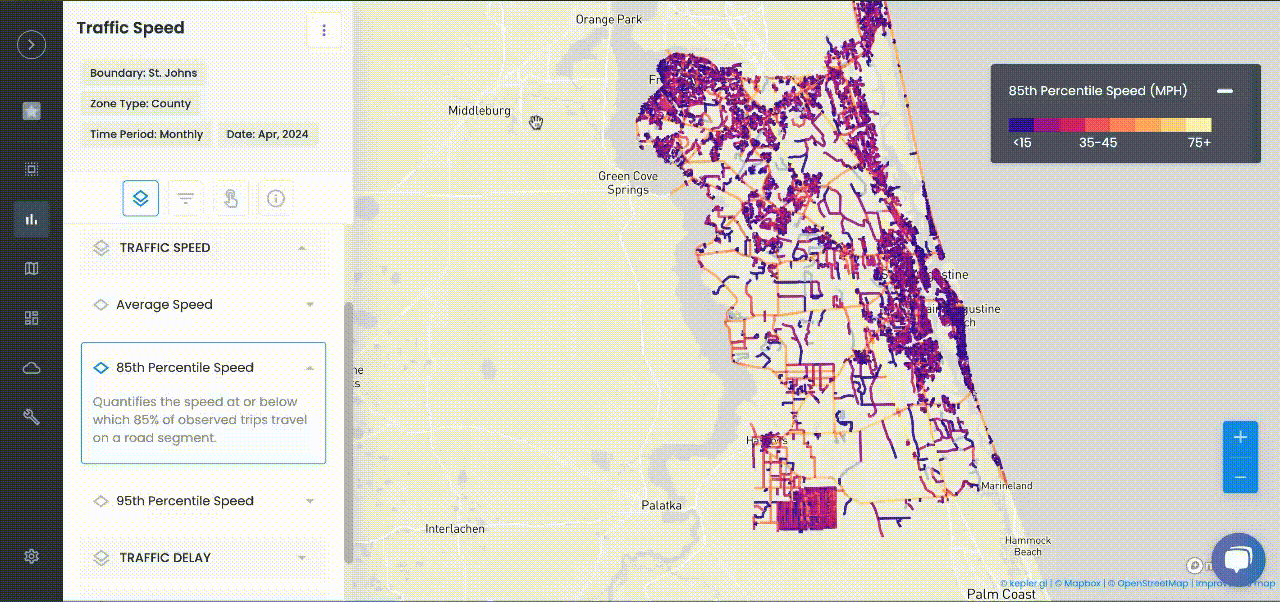
Transportation Planning
Optimizing Curbside Management: Dynamic Pricing and Analytics for Parking and Loading Zones
Real-time data, dynamic pricing, and smart curbside analytics helps cities manage parking, loading zones, and curb access
On busy city streets, the curbside is prime real estate. It serves many competing purposes—parking for private cars, loading zones for delivery trucks, pick-up/drop-off spots for rideshares and taxis, bus stops, bike and scooter parking, outdoor dining, and more. Traditionally, cities managed curbs with static rules: fixed parking meter rates (if any), “No Parking” signs for certain hours, and a few first-come-first-served loading zones. The result has been predictable chaos: drivers circling for cheap parking, trucks double-parking when loading zones are full, and general congestion and safety hazards.
To solve this, cities are turning to dynamic curbside management, using real-time data and flexible pricing or regulations to allocate curb space more efficiently. By applying supply-and-demand principles and leveraging sensors and analytics, cities can ensure the curb serves the right use at the right time—reducing congestion, improving turnover, and even raising revenue to reinvest in transport.
The Case for Dynamic Pricing
A foundational strategy is demand-based pricing for curb parking. Research led by Donald Shoup at UCLA famously showed that underpriced (or free) curb parking leads to rampant “cruising”—drivers circling blocks hunting for a spot, generating significant traffic. Cities like San Francisco demonstrated this with the SFpark pilot: sensors tracked occupancy and prices were dynamically adjusted to maintain optimal availability. The result: cruising dropped dramatically, double-parking fell, transit buses ran faster, and revenue stabilized.
Real-Time Data for Curb Analytics
Key to dynamic management is having live data on curb usage. Many cities now deploy smart parking sensors or camera analytics to track which curb spaces are occupied at any moment. Platforms aggregate meter, sensor, and payment data to provide a citywide occupancy dashboard. With this data, cities set variable rates by hour or location and use hot‑spot maps to guide enforcement to areas with illegal behavior.
Moreover, detailed parking inventory data supports broader congestion planning by revealing where curb spaces are used instead of travel lanes—helping balance safety and flow. Urban SDK offers datatypes that map parking usage alongside traffic volumes and speeds—enabling planners to visualize curb blockages and lane conflicts as part of overall mobility analysis
Smart Loading Zones and Delivery Management
Beyond private car parking, curbside pressures come from deliveries and ride-hail vehicles. Cities are piloting smart loading zones, where delivery drivers can reserve spots via an app, rather than double-park. These systems collect data on usage duration and timing, enabling tailored adjustments in rules or hours.
For example, if data shows that a block’s loading zone is overwhelmed at 10 AM, cities might extend its hours or add additional zones nearby. Dynamic pricing may also apply—charging $0.50 to $1.00 for reserved loading time—to incentivize turnover. Usage data further informs curb redesign: underused zones may be repurposed; overused ones expanded.
These strategies reduce conflicts between parked, loading, and moving vehicles, improving safety and flow—especially important when bike lanes and transit are adjacent.
Policy Meets Tech—A Holistic Approach
For tech-enabled curb management to succeed, policy and regulations must keep up. Many cities are updating curb ordinances to allow flexible designations—e.g. travel lane during rush hour, loading zone midday, paid parking in the evening—communicated via digital signage or apps.
Thought leaders argue that curbs have been managed “one-dimensionally” since the first parking meter in 1935. Now, with dynamic data and flexible rules, cities can treat the curb as a valuable, multi-use asset—reducing double-parking, balancing competing uses, and generating revenue to reinvest in transit or streetscape upgrades.
Benefits in Practice
Reforms yield visible gains. San Francisco’s dynamic-pricing pilot led to reduced cruising and faster bus service. In higher-density, transit-oriented neighborhoods, proactive curb planning has helped shift car usage to walking and transit—reducing dependence on private vehicles and improving safety.
How Urban SDK Supports Curbside Strategy
Urban SDK provides the analytics infrastructure cities need to implement dynamic curbside systems:
- Ability to upload parking inventory data, integrated with road and curb characteristics traffic patterns, helps to visualize how curb space is utilized across modes.
- Real-time traffic volume and travel delay metrics allow planners to see how loading or double parking disrupts travel lanes and speeds.
- Segments flagged by high congestion can be automatically flagged using workflows, and routed to appropriate personnel for enforcement or redesign—and tied into traffic safety analytics for broader risk mitigation.
The Future of Smart Curbs
In the near future, you might see parking rates update in real time via apps, or delivery drivers paying small fees for guaranteed reserved loading zones. Though the transition may feel unfamiliar at first, the payoff is smoother streets, happier businesses, safer sidewalks, and smarter use of public space.
Dynamic curb management isn’t just about technology—it requires iterative learning and policy feedback. As cities deploy these systems, usage patterns will be refined, pricing adjusted, and the system optimized over time.
Final Thoughts
Dynamic analytics and flexible pricing make the curb smarter, not stricter. By treating curbside as a real-time, multi-purpose asset, cities can reduce congestion, improve safety, support transit, and generate funds for sustainable mobility.
With Urban SDK’s parking data, traffic flow metrics, and predictive modeling tools, city planners and transit officials can turn curb chaos into coordinated curb management—serving people better, not cars.
FAQs
Q1. What is dynamic curbside management in urban areas?
Ans: Dynamic curbside management uses real-time data and flexible pricing to allocate curb space efficiently among parking, loading, rideshare pick-up, and other uses - moving beyond static rules to reduce congestion and conflicts.
Q2. How does dynamic pricing help optimize curb space usage?
Ans: By adjusting parking and loading fees based on demand, cities discourage cruising for cheap spots and incentivize turnover. This leads to better availability of curb space and reduced double parking, easing traffic flow.
Q3. What types of data support dynamic curbside pricing?
Ans: Sensors, cameras, payment systems, and GPS data track curb occupancy, dwell times, and illegal parking. Integrated analytics platforms combine these layers to help cities monitor usage and adjust pricing policies dynamically.
Q4. How do smart loading zones work with dynamic curb management?
Ans: Smart loading zones allow delivery drivers to reserve curb space via apps and pay usage fees that vary by location and time. This reduces double parking and congestion caused by trucks waiting for available spots.
Q5. What are the benefits of dynamic curb pricing for cities?
Ans: Benefits include reduced cruising-related emissions, improved traffic safety, higher turnover of curb spaces, enhanced revenues for reinvestment, and better equity by designing policies sensitive to community needs.
Q6. How are cities addressing privacy and technical challenges in smart curb systems?
Ans: Cities implement privacy safeguards like blurring identifiable data, use secure architectures against hacking, and ensure interoperability with open standards to future-proof systems.
Q7. Can dynamic curbside pricing be tailored to promote equity?
Ans: Yes. Cities can design pricing variations or discounts for residents, people with disabilities, or underserved neighborhoods to ensure fair access to curb resources.
Q8. How do cities monitor and enforce compliance with dynamic curb policies?
Ans: AI-powered cameras and sensors facilitate real-time monitoring. Combined with digital payment systems, these tools improve compliance while reducing manual enforcement costs.
Q9. What are examples of dynamic curbside management successes?
Ans: San Francisco’s SFpark pilot saw reduced cruising and emissions. Australian cities like Melbourne and Sydney used dynamic pricing to smooth parking turnover and generate revenue for transport.
Q10. How can Urban SDK help cities implement dynamic curb management?Ans: Urban SDK integrates mobility, traffic, and parking data into dashboards and simulation tools that visualize curb usage, assess pricing impacts, and guide enforcement and planning decisions in real time.

TRAFFIC ENFORCEMENT FEATURES
80% of citizen complaints
are a perception problem
Urban SDK provides precise hourly speed data to evaluate complaints and deploy resources efficiently for the greatest impact to public safety.
Urban SDK provides precise hourly speed data to evaluate complaints and deploy resources efficiently for the greatest impact to public safety.
Target Speeding
Identify hot spots, validate monthly speeding trends and monitor vulnerable areas like school zones.
Improve Safety
Crash and citations location information to compare speed trends month over month
Fast Response
Respond to citizen complaints sooner with address search and exportable reporting
Deploy Assets
Generate maps for traffic enforcement by time of day, location or division to deploy officers to known problem areas.
RESOURCES
Customer Success
See how public sector leaders succeed with Urban SDK.
WEBINAR
Identify speeding and proactively enforce issues
See just how quick and easy it is to identify speeding, address complaints, and deploy officers.







